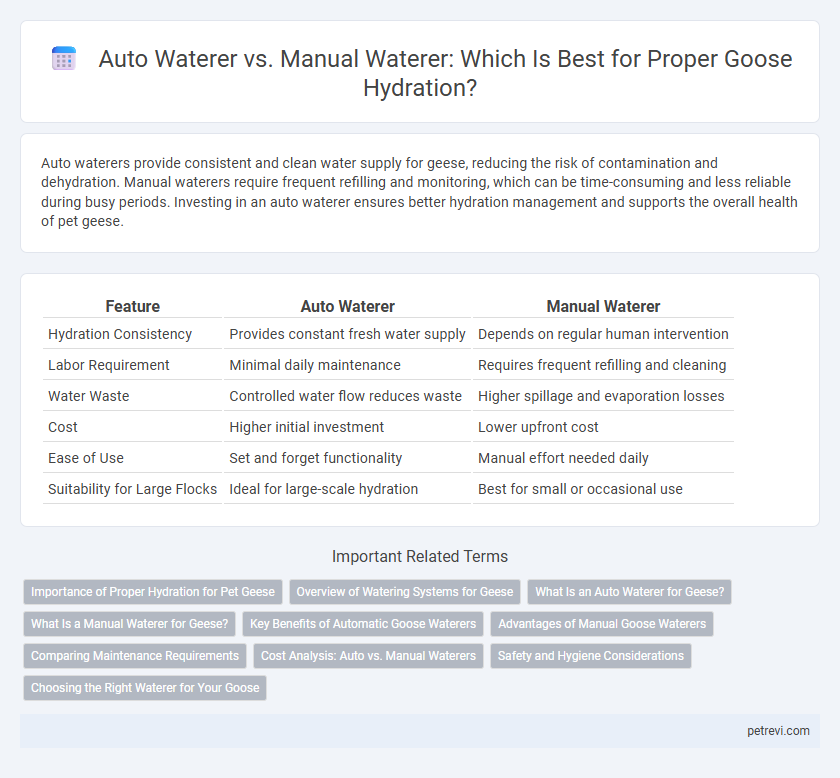Auto waterers provide consistent and clean water supply for geese, reducing the risk of contamination and dehydration. Manual waterers require frequent refilling and monitoring, which can be time-consuming and less reliable during busy periods. Investing in an auto waterer ensures better hydration management and supports the overall health of pet geese.
Table of Comparison
| Feature | Auto Waterer | Manual Waterer |
|---|---|---|
| Hydration Consistency | Provides constant fresh water supply | Depends on regular human intervention |
| Labor Requirement | Minimal daily maintenance | Requires frequent refilling and cleaning |
| Water Waste | Controlled water flow reduces waste | Higher spillage and evaporation losses |
| Cost | Higher initial investment | Lower upfront cost |
| Ease of Use | Set and forget functionality | Manual effort needed daily |
| Suitability for Large Flocks | Ideal for large-scale hydration | Best for small or occasional use |
Importance of Proper Hydration for Pet Geese
Proper hydration is crucial for maintaining the health and well-being of pet geese, as it supports digestion, temperature regulation, and immune function. Auto waterers provide a consistent, clean water supply, reducing the risk of dehydration and bacterial contamination compared to manual waterers, which may lead to irregular water access. Ensuring constant hydration through efficient watering systems enhances goose vitality and prevents common health issues such as respiratory infections and dehydration-related stress.
Overview of Watering Systems for Geese
Auto waterers for geese provide a consistent supply of fresh water, reducing contamination risks and saving labor compared to manual waterers. Manual waterers require regular refilling and cleaning, increasing labor demands but offering direct control over water quality and volume. Efficient hydration systems are essential for maintaining geese health, supporting growth, and preventing dehydration-related issues.
What Is an Auto Waterer for Geese?
An auto waterer for geese is an automated irrigation system designed to provide a constant and clean supply of water without the need for manual refilling. These devices typically regulate water levels using a float valve or sensor mechanism, ensuring geese have access to fresh water throughout the day. Compared to manual waterers, auto waterers reduce labor and minimize water contamination, promoting better hydration and health in geese flocks.
What Is a Manual Waterer for Geese?
A manual waterer for geese is a simple device that requires regular refilling and monitoring to ensure fresh water availability. It typically consists of a water container or trough that must be manually refreshed to maintain hydration and cleanliness. Using a manual waterer demands more time and effort compared to an automatic system but offers control over water quality and consumption.
Key Benefits of Automatic Goose Waterers
Automatic goose waterers provide consistent and clean water supply, reducing the risk of contamination and disease common in manual waterers. These systems save time and labor by maintaining optimal hydration levels without daily refilling, ensuring geese remain healthy and productive. The automation also minimizes water waste and promotes better water management, contributing to overall farm efficiency.
Advantages of Manual Goose Waterers
Manual goose waterers offer precise control over water distribution, reducing waste and ensuring fresh water availability tailored to the specific needs of geese. They require minimal initial investment and maintenance, making them cost-effective and simple for small-scale or backyard flocks. Manual waterers also allow for regular cleaning and monitoring, which helps prevent contamination and promotes better hydration and health in geese.
Comparing Maintenance Requirements
Auto waterers for geese significantly reduce maintenance time by providing a continuous water supply and minimizing water contamination risks, while manual waterers require frequent refilling and cleaning to ensure fresh water availability. Automatic systems often incorporate self-cleaning features and durable materials that lower the frequency of upkeep compared to the labor-intensive manual approach. Choosing an auto waterer improves consistency in hydration and decreases the daily labor demands associated with goose care.
Cost Analysis: Auto vs. Manual Waterers
Auto waterers for goose hydration typically involve a higher upfront investment ranging from $100 to $300, but offer long-term savings through reduced labor and consistent water supply, which lowers the risk of dehydration-related health issues. Manual waterers cost as little as $10 to $50 initially but require frequent refilling and monitoring, increasing labor costs and potential water wastage. Evaluating the total cost of ownership reveals that automatic systems provide better economic efficiency for large or commercial flocks, while manual watering suits small-scale or budget-conscious operations.
Safety and Hygiene Considerations
Auto waterers for geese provide consistent, clean water supply, reducing the risk of contamination and promoting better hydration compared to manual waterers that can become breeding grounds for bacteria due to stagnant water. Automated systems minimize human contact, lowering the chance of transmitting pathogens and ensuring safer drinking conditions for geese. Proper maintenance and regular cleaning of auto waterers are essential to sustain hygiene standards and prevent waterborne diseases in flocks.
Choosing the Right Waterer for Your Goose
Selecting the right waterer for your goose is crucial to ensure optimal hydration and health. Auto waterers provide a consistent and clean water supply, reducing the risk of contamination and saving time, while manual waterers offer greater control but require frequent refilling and cleaning. Evaluating your flock size, daily maintenance capacity, and water quality needs will help determine whether an auto or manual waterer suits your goose-keeping setup best.
Auto Waterer vs Manual Waterer for Goose Hydration Infographic

 petrevi.com
petrevi.com